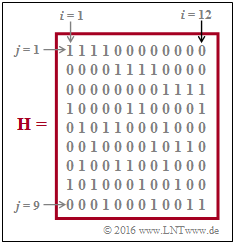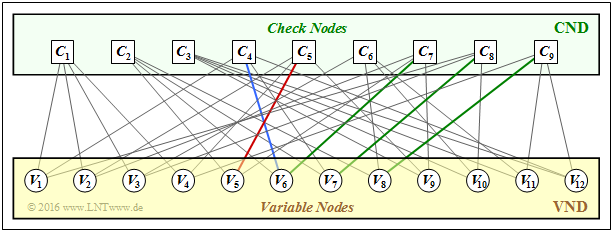Exercise 4.13: Decoding LDPC Codes
The exercise deals with "Iterative decoding of LDPC–codes" according to the Message passing algorithm.
The starting point is the presented $9 × 12$ parity-check matrix $\mathbf{H}$, which is to be represented as Tanner graph at the beginning of the exercise. It should be noted:
- The "variable nodes" $V_i$ denote the $n$ bits of the code word.
- The "check nodes" $C_j$ represent the $m$ parity-check equations.
- A connection between $V_i$ and $C_j$ indicates that the element of matrix $\mathbf{H}$ $($in row $j$, column $i)$ is $h_{j,\hspace{0.05cm} i} =1$.
- For $h_{j,\hspace{0.05cm}i} = 0$ there is no connection between $V_i$ and $C_j$.
- The "neighbors $N(V_i)$ of $V_i$" is called the set of all check nodes $C_j$ connected to $V_i$ in the Tanner graph.
- Correspondingly, to $N(C_j)$ belong all variable nodes $V_i$ with a connection to $C_j$.
The decoding is performed alternately with respect to
- the variable nodes ⇒ "variable nodes decoder" $\rm (VND)$, and
- the check nodes ⇒ "check nodes decoder" $\rm (CND)$.
This is referred to in subtasks (5) and (6).
Hints:
- The exercise belongs to the chapter "Basic information about Low–density Parity–check Codes".
- Reference is made in particular to the section "Iterative decoding of LDPC codes".
Questions
Solution
- From the column number of the $\mathbf{H}$ matrix, we can see $I_{\rm VN} = n \ \underline{= 12}$.
- For the set of all variable nodes, one can thus write in general: ${\rm VN} = \{V_1, \hspace{0.05cm} \text{...} \hspace{0.05cm} , V_i, \hspace{0.05cm} \text{...} \hspace{0.05cm} , \ V_n\}$.
- The check node $ C_j$ represents the $j$th parity-check equation, and for the set of all check nodes:
- $${\rm CN} = \{C_1, \hspace{0.05cm} \text{...} \hspace{0.05cm} , \ C_j, \hspace{0.05cm} \text{...} \hspace{0.05cm} , \ C_m\}.$$
- From the number of rows of the $\mathbf{H}$ matrix we get $I_{\rm CN} \ \underline {= m = 9}$.
(2) The results can be read from the Tanner graph sketched on the right.
Correct are the proposed solutions 1, 2 and 5:
- The element $h_{5,\hspace{0.05cm}5}=1$ $($column 5, row 5$)$ ⇒ red edge.
- The element $h_{4,\hspace{0.05cm} 6}=1$ $($column 4, row 6$)$ ⇒ blue edge.
- The element $h_{6, \hspace{0.05cm}4}=0$ $($column 6, row 4$)$ ⇒ no edge.
- $h_{6,\hspace{0.05cm} 10} = h_{6,\hspace{0.05cm} 11} = 1$, $h_{6,\hspace{0.05cm}12} = 0$ ⇒ not all three edges exist.
- It holds $h_{7,\hspace{0.05cm}6} = h_{8,\hspace{0.05cm}7} = h_{9,\hspace{0.05cm}8} = 1$ ⇒ green edges.
(3) It is a regular LDPC code with
- $w_{\rm R}(j) = 4 = w_{\rm R}$ for $1 ≤ j ≤ 9$,
- $w_{\rm C}(i) = 3 = w_{\rm C}$ for $1 ≤ i ≤ 12$.
The answers 2 and 3 are correct, as can be seen from the first row and ninth column, respectively, of the parity-check matrix $\mathbf{H}$.
The Tanner graph confirms these results:
- From $C_1$ there are edges to $V_1, \ V_2, \ V_3$, and $V_4$.
- From $V_9$ there are edges to $C_3, \ C_5$, and $C_7$.
The answers 1 and 4 cannot be correct already because
- the neighborhood $N(V_i)$ of each variable node $V_i$ contains exactly $w_{\rm C} = 3$ elements, and
- the neighborhood $N(C_j)$ of each check node $C_j$ contains exactly $w_{\rm R} = 4$ elements.
(4) Correct are the proposed solutions 1 and 2, as can be seen from the "corresponding theory page":
- At the start of decoding $($so to speak at iteration $I=0)$ the $L$–values of the variable nodes ⇒ $L(V_i)$ are preallocated with the channel input values.
- Later $($from iteration $I = 1)$ the log likelihood ratio $L(C_j → V_i)$ transmitted by the CND is considered in the VND as a-priori information.
- Answer 3 is wrong. Rather, the correct answer would be: There are analogies between the VND algorithm and the decoding of a "repetition code".
(5) Correct is only proposed solution 3 because
- the final a-posteriori $L$–values are derived from the VND, not from the CND;
- the $L$–value $L(C_j → V_i)$ represents extrinsic information for the CND; and
- there are indeed analogies between the CND algorithm and SPC decoding.

